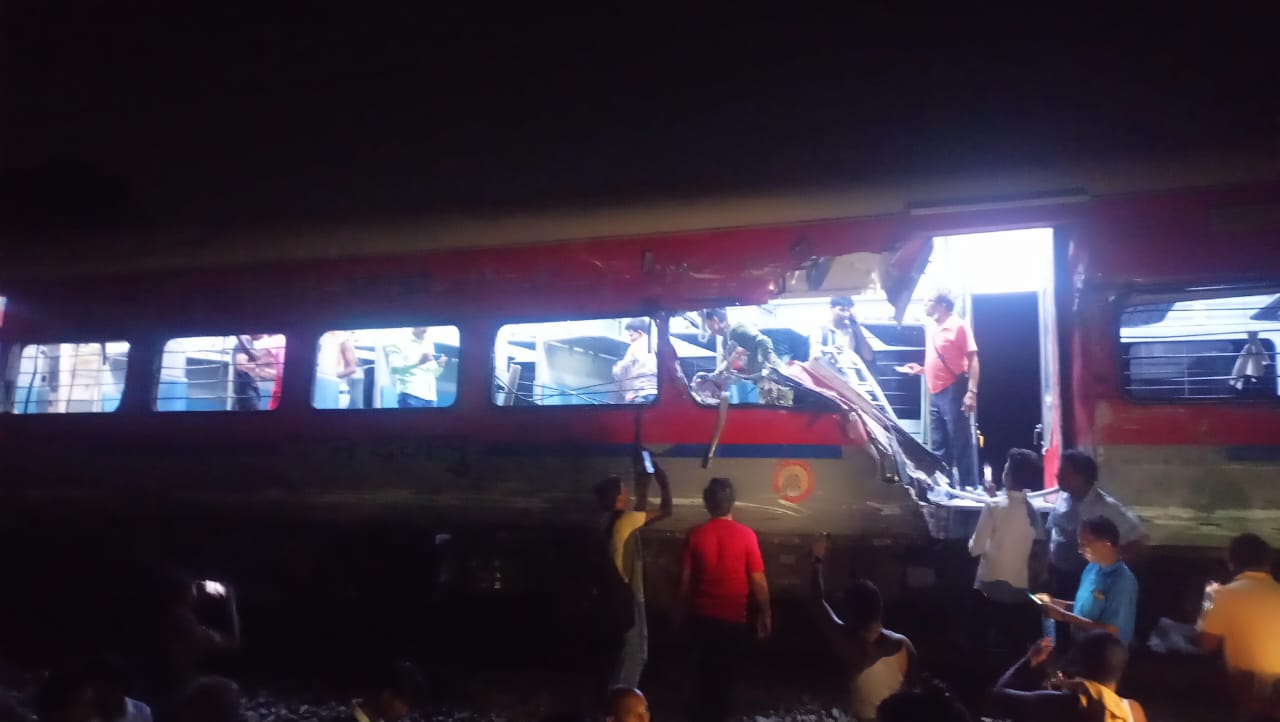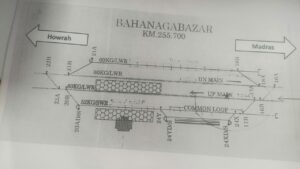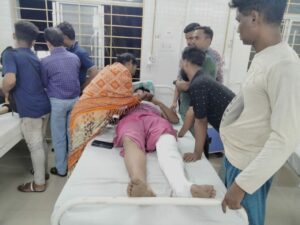PM Modi visits crash site, says those responsible will not be spared; AM Chowdhary, Commissioner of Railway Safety, South Eastern Circle, to probe accident.

AM Chowdhary, Commissioner Railway Safety, South East Circle, will probe the accident. Incidentally, the Commissioner Railway Safety, comes under the Ministry of Civil Aviation. (Supplied)
A combination of factors led to the three-train crash — one of India’s worst — at the Bahanagar Bazaar Station in Odisha on Friday, 2 June, that killed at least 288 people and injured around 1,100 others, it was revealed on Saturday.
Preliminary investigations revealed that the Chennai-bound 12841 Shalimar-Chennai Central Coromandel Express entered a loop line — instead of the main line — at 128 kmph and smashed into a stationary freight train.
On impact, 21 compartments of the Coromandel Express derailed and three of them scattered on the adjacent (down) line on which the Howrah-bound 12864 Sir M Visvesvaraya-Howrah Superfast Express was hurtling at 116 kmph in the opposite direction.
The last two carriages of the Howrah-bound superfast derailed after the train collided with Coromandel’s compartments around 7 pm on Friday, the preliminary report submitted to the Railway Ministry said.
The Railways has ordered a high-level probe by AM Chowdhary, the commissioner of railway safety, South Eastern Circle, officials said.
The two trains were carrying close to 2,300 reserved passengers — 1,257 on Coromandel, and 1,039 on the superfast.

The Coromandel Express reportedly sped into the loop line where the freight train was parked, and rammed it. (Sourced)
Loop lines are constructed in station areas to accommodate more trains to ease out the operations. They are generally 750 metres long to accommodate full-length goods train with multiple locomotives.
The crash site at Bahanagar Bazaar Station is located 171 km from Odisha’s capital Bhubaneswar and 166 km from Kharagpur, a major industrial city in the Paschim Medinipur district of West Bengal.
Earlier, South-Eastern Railway (SER) spokesperson Aditya Chowdhury said that the Howrah superfast had derailed and ran into Coromandel’s track, causing the accident.
“These derailed coaches collided with the 12841 Shalimar-Chennai Central Coromandel Express and its coaches capsized too,” news agency PTI quoted him as saying.
An eyewitness to the incident, Anubhav Das, told PTI that local authorities and railway officials had initially indicated that the train he was travelling on — Coromandel Express — had rammed into the goods train.
Prime Minister Narendra Modi choppered into Balasore and visited the crash site on Saturday. He was accompanied by Union Railway Minister Ashwini Vaishnaw and Education Minister Dharmendra Pradhan.
Saying those responsible for the crash would be severely punished, Modi said the government is standing with the bereaved families.
“The government will leave no stone unturned for the treatment of those injured. It’s a serious incident, instructions have been issued to probe every angle. Those found guilty will be severely punished,” he said.
The prime minister, who took an IAF helicopter to Bahanaga, visited the injured at the Balasore District Hospital.
Modi asked the cabinet secretary and health minister to provide all help to the injured and their families.
Earlier, he convened a meeting to review the situation in New Delhi. Union Home Minister Amit Shah and senior officials attended the meeting.
Railway Minister Vaishnaw reached the site in the morning as did Odisha Chief Minister Patnaik and his West Bengal counterpart Mamata Banerjee.
Soon after the devastating crash, Opposition parties demanded Vaishaw’s resignation.
Rescue workers who reached the crash site used gas cutters to extricate the bodies from under the derailed coaches. From a vantage point high above the ground, the accident site looked as if a powerful whirlwind had thrown the coaches on top of each other.
Closer to the ground, bloodied and disfigured bodies lay enmeshed with each other, creating a grotesque sight.
The railway tracks were almost destroyed at the spot as mangled coaches lay strewn all over, with some having mounted on another, while a few coaches overturned due to the impact.
The railways has announced an ex gratia of ₹10 lakh for the next of kin of the deceased, ₹2 lakh for those grievously injured, and ₹50,000 for those with minor injuries.
Modi has announced an additional ex gratia of ₹2 lakh for the next of kin of the deceased and ₹50,000 for the injured from the Prime Minister’s National Relief Fund.
The rescue operation is continuing with one coach posing a huge challenge, according to the latest official update that put the casualties at 288 and the number of injured at around 1,100.
“Only one bogie is left, which is severely damaged. The National Disaster Response Force (NDRF), the Odisha Disaster Rapid Action Force (ODRAF), and the Fire Service are still working to cut the bogie and recover the living or the dead,” Odisha Chief Secretary PK Jena told reporters.
Around 200 ambulances, 50 buses, and 45 mobile health units, besides 1,200 personnel, are working at the accident site, with officials saying the tragedy was compounded due to multiple tracks passing through an embanked area.
Army columns, including engineering and medical personnel, have been rushed to the accident site from its installations at Barrackpore and Panagarh in West Bengal. Two Mi-17 helicopters were deployed to evacuate the injured passengers, a defence official said on Saturday.
The national transporter also said the anti-train collision system, Kavach — or armour — was not available on the route. The railways is in the process of installing Kavach, an anti-train collision system, across its network.
Kavach alerts when a loco pilot jumps a signal (Signal Passed at Danger — SPAD), which is the leading cause of train collisions. The system can alert the loco pilot, take control of the brakes and bring the train to a halt automatically when it notices another train on the same line within a prescribed distance.
Amitabh Sharma said the Railways have now taken up restoration works of the tracks. The accident affected as many as 18 long-distance trains.
While a thorough probe is underway, none of the authorities has so far talked about any possibility of sabotage.
News agencies said the preliminary probe reported that the signal was given and taken off for the up main line for Coromandel, and the train entered the loop line, crashed into the goods train, and derailed.
In the meantime, train number 12864 (Howrah Superfast) passed through the down main line and two of its coaches derailed and overturned, the report said.
Sudhanshu Mani, the former general manager of the Integral Coach Factory, Chennai, and the man who led the team that made the first Vande Bharat train, prima facie ruled out any error on the part of the two loco pilots involved in the tragedy.
He opined that the primary reason for the mass casualty is the first derailment and the unfortunate timing of the second passenger train, which came from the other direction at a very high speed.
Mani said if it was just the first train derailing, the LHB (Linke Hofmann Busch) coaches would not have capsized and so many casualties would not have been reported.
“Although the reason for the derailment of the first train cannot be a matter of conjecture, as of now, I do not see any evidence of an SPAD case, meaning the driver overriding signals. It was going on the correct path as the data logger shows that the signal was green,” Mani said.
In February, close on the heels of a head-on collision between two goods trains in Uttar Pradesh, the railways launched a month-long safety drive to prevent accidents such as derailment and overshooting of signals by loco pilots.
Under the drive, senior officers from the Railway Board, zonal railways, and divisions were instructed to visit various sections, lobbies of crews, maintenance centres, work sites, etc, and carry out a “thorough review of the working practices” to check and enforce safe operation and maintenance practices prescribed to prevent accidents or unusual incidents.
Former Member Traffic, Railway Board, Sri Prakash also said the driver of the second train at such a high speed could have done little to limit the damage.
“It depends on how much time one has and what speed the train is at for the driver to apply the brakes and stop the train. It is rare for a passenger train to derail while it is most common in the case of goods trains. What the investigators find as the cause of the derailment will be key,” he said.
Locals residents said they heard consecutive loud sounds, and they rushed to the spot and found the derailed coaches.

Balasore district hospital looked like a war zone with the injured lying on stretchers in the corridor and rooms bursting at its seams with extra beds propped up. (Supplied)
“The local people went out on a limb to help us… They not only helped pull out people but retrieved our luggage and got us water,” Rupam Banerjee, one of the passengers, told reporters.
The Balasore district hospital looked like a war zone with the injured lying on stretchers in the corridor and the wards struggling to accommodate all the patients.
Harried medical staff was seen trying to bring succour to the patients, many of whom are from states outside Odisha and had difficulties communicating. In all, 526 accident victims have been admitted to the hospital.
More than 2,000 people gathered at the Balasore Medical College and Hospital at night to help the injured and many of them donated blood, officials said.
The morgue at the hospital was a pile of white-shrouded bodies, many of those not identified as relatives are yet to reach the town with many trains cancelled or delayed due to the accident on a major railway trunk route.
Doctors from AIIMS-Bhubaneswar have been dispatched to Balasore and Cuttack to assist in the relief operations, Union Health Minister Mansukh Mandaviya said.
Odisha Chief Minister Naveen Patnaik declared a daylong state mourning on Saturday.
The Tamil Nadu government has made arrangements to ensure the return of the stranded and injured passengers to the southern state, and a high-level delegation comprising ministers and officials has been sent to coordinate the rescue-and-relief activities at the site, Chief Minister MK Stalin said.
Karnataka Chief Minister Siddaramaiah has deputed a team led by Labour Minister Santosh Lad to ensure the safety of the people from the state in the aftermath of the accident.
Two trains carrying around 1,200 passengers of the trains involved in the gruesome accident will arrive at Howrah on Saturday, a South Eastern Railway official said.
While one of the trains is carrying 1,000 passengers, another is on its way from Balasore to Howrah with around 200 passengers, he added.
A special train to Chennai ferrying the crash survivors left Bhubaneshwar at 8.30 am.
(With PTI inputs)